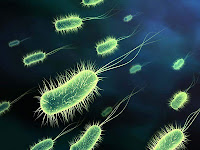Bacterias are unicelular microoganisms of a few micrometers long. They don't have a nucleus or organelles like animal and plant cells, but they have a cell wall. Almost all bacterias have flagellum or other movement system.
CLASIFICATION
 (According the shape)
(According the shape) COCOS: Spheric shape.
BACILES: Bar shape
VIBRIOS: Corkscrew shape
ESPILOS: Propeller shape
3 VITAL FUNTIONS
METABOLISM: There are 3 important criteria: Carbon origin, energy source and electrons donors.
REPRODUCTION: Bacterias have an asexual reproduction, one bacteria divides in two.
INTERACTION: There are 3 partnerships: parasitisms, mutualism and commensalism.
PARTS
 The parts of a bacteria are:
The parts of a bacteria are:*cell wall
*flagellum
*cytoplasm
* DNA
*plasmidane
*ribosome
*pilus
*plasma membrane
*cabsule
FUN FACTS
The bacterias are the most abundant organisms in the world.
There are bacterias in all terrestrial and marine habitats and also in the most extremes like radioactive waste.
Bacterias can survive in the space!
The first bacteria appears 1.000 million years ago.
There are 10 times more bacterias than human cells in the human body.
In the industry bacterias are very important. For examplre: To make yogurts.
In Spain 35.000 people die by bacterias. (30 times more than with car accidents.)
No hay comentarios:
Publicar un comentario